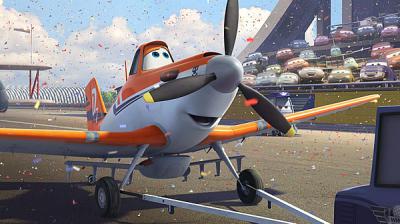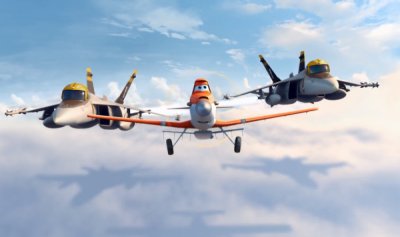By: debbie lynn elias
According to DISNEY’S PLANES director Klay Hall, executive producer John Lasseter has several rules that he lives by. “One of them is to do your research and then do some more research and get your facts right.” Never is this philosophy more important that in a film like DISNEY’S PLANES where the audience needs to feel immersed and engaged with animated characters who need to feel realer than real. For Hall, “[W]hen you get out there and you talk the talk and you walk the walk with [the experts], what happens is those elements work their way into the film. . .that adds a level of truth and believability to your film that elevates the film to a whole other area.” With DISNEY’S PLANES, Hall and company weren’t “faking anything”, starting with determining the type of aircraft to include as characters and animate.

As Hall notes, “The airplane universe is vast. We knew we wanted a wide variety of aircraft. We wanted old and we wanted new and we wanted the guys in-between. . .You can look at an airplane and just by it sitting there, you can kind of tell if it’s a timid aircraft, you can kinda tell if it’s strong and tough, you can kind of get a general idea just by the shape of the airplane of a basic personality. So you want to start there just as far as a place to start with.” Their search paid off as DISNEY’S PLANES showcases, among others, a vintage Navy Corsair, F-18s, cropdusters, the British Spitfire, the popular GB, biplanes and even a sneak peek at the new 777-300ER.
But just looking at aircraft isn’t enough. Character voicing comes into play as Hall and his team, including Lasseter, producer Traci Balthozar-Flynn and casting director Jason Hinkel, look to their “wish list of actors”. Proud of the fact that “We’re not stunt casting here. We’re going for fun, interesting voices”, the casting process starts with the visual of a particular plane. “We would take voices and just show the visual on the screen with the voices. We would capture either a movie role or a tv role or a stand-up comedian’s role, and we will play that voice with that visual back and forth a few times. . .[Y]ou can get a pretty good idea if that character seems believable and was resonating from that type of aircraft. So that put us in the zone. Then also, things like El Chupacabra with the GB, we also looked at the history of aviation and what planes were famous in what areas. That was another thing that helped inform us. Then it was all that stuff coming together.”
With DISNEY’S PLANES, however, it was more than the look and personality of a plane that went into the story. Technical logistics and limitations also came into play when it was time to plan out the world rally race. “Once we knew that we had landed on Dusty’s aircraft. . .we met with a group of pilots and we were like, ‘Okay, if I’m gonna fly this airplane around the world, how could I do it? I’m gonna start from New York.’ And they were like, ‘Okay. He’s this size; he weighs this much; he can carry this much gas. He’s gonna have to go to Iceland first. And from Iceland he’ll have to go to Germany.’ And that’s actually how the route came about. It was where [Dusty] could fly that dictated the believability of the whole thing.”

But having the look and the route isn’t everything for this Disneytoon Studios film. Authentic sound is equally important for each and every plane and that’s where Klay Hall can’t sing enough praises for his sound team. “ We had an amazing sound team that went out and actually miked probably 21, 22 different types of aircraft from the engines – they miked the engines, they miked the starter areas, the propellers, they even miked the rear wheels so when the plane rolled across gravel versus rolled across grass versus rolled across asphalt, it sounded different. All of that has been incorporated into the film. Each one of those planes has a different sound.” Producer Flynn heartily agrees noting that “Even the Department of Defense was able to hook us up with F-18s at Point Mugu. Those are actual authentic engine sounds.”

Speaking of F-18’s, some of the most enthralling scenes in DISNEY’S PLANES involves F-18 fighter jets and a nuclear powered aircraft carrier. According to Hall, “With our military sequences in the film, they had to be spot on.” In order to achieve that “spot on” element and as part of the production research, the filmmakers “were invited by the Navy to go out to the USS Carl Vinson, a nuclear powered aircraft carrier, 150 miles out to sea off of San Diego, and spend 2 days with the men and women on the carrier and talk to the flight team, the executive officers and the captain. W e actually sat down and we screened those sections of the film for that team to weigh in on. Overall, they really liked them. They gave us little notes about adjusting here and there but the facts were right. The captain even said, ‘I could sit here with a bunch of my friends and I’d swear to God that that was myself and them talking.’”
#












